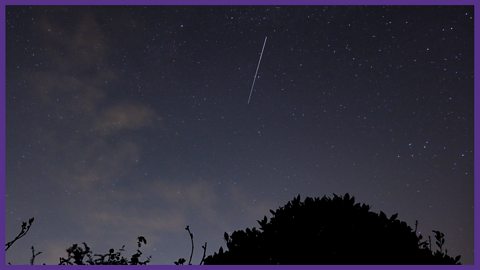There's nothing better, when you're wrapped up warm in an evening watching the sky slowly turn inky blue, than spotting those little pins of light popping into focus one by one. Soon, you might even start to recognise familiar shapes and patternsтІ
This guide, created in partnership with the , will help you and your child find and recognise some of the most famous constellations in our night sky.
What are constellations and asterisms?
There are two names given to patterns of stars: asterisms, and constellations.
Asterisms are easily recognisable patterns of stars that are usually fairly easy to spot. Constellations are officially recognised patterns in the night sky that help astronomers divide the sky into sections.
Before you read more about how to spot them - test your knowledge with this quick quizтІ
Quiz - Can you guess the constellation?

Top tips for stargazing
Check the weather forecast. It needs to be a clear night for stargazing.
Try to find a darker area without too much light pollution. If you want to do back garden constellation spotting, turn off any unnecessary lights.
Donтt look at phone or tablet screens. If you need to use a light, use a red light or low level light as it wonтt ruin your night vision. There are several useful free apps to download that can help you find different constellations and other objects in the sky. If youтre using one of these make sure to limit the amount of time spent looking at the screen, or switch to a night mode.
Try and have an idea of which direction north, south, east, and west are from your observing location. You can use the direction of the setting Sun to work out which way is west to help you determine other directions.
Find some more tips for navigating the night sky, with this article from ТщЖЙдМХФ Bitesize Topical.

How to spot famous constellations and asterisms
More suitable for 6-11 year olds
The Plough

The Plough, sometimes known as The Big Dipper, is one of the most famous asterisms in the northern hemisphere and a great place to start for stargazing. It is visible all year round from the UK. This asterism is in the constellation of Ursa Major which translates to the 'big bear'.
1. Look towards the northern horizon if you know your direction, or just scan the skies and look for seven stars that make up the shape of a saucepan.
2. Three stars make up the тhandleт.
3. Four stars make up the тbowlт.
4. Depending on the time and the season the Plough may be seen in rotated positions.
Ursa Major
Ursa Major is visible all year round from the UK. The Plough makes up hindquarters and tail of the bear. The rest of the constellation is dimmer and may be harder to spot.
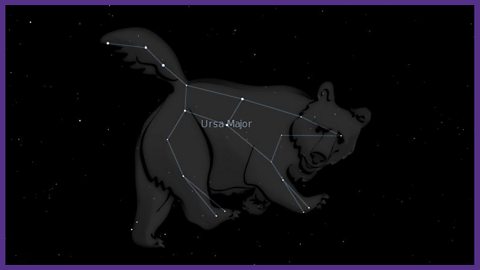 Image source, Wikimedia Commons: Stu10255
Image source, Wikimedia Commons: Stu102551. To stargaze you do not need to know the names of the stars but they can help orientate yourself. The names of the stars that make up the тhandleт of the Plough are Alkaid, Mizar and Alioth. Megrez, Dubhe, Phecda and Merak make up the тbowlт. You can see them in the image of the Plough above.
2. To find the head of the bear follow the invisible line from Megrez to Dubhe and then keep going roughly the same distance again from Dubhe, this brings you to a fainter star which is the ear of the bear. If you continue to follow this straight line roughly the same distance again you get to the bearтs nose.
Ursa Minor
As well as the big bear, there is also the little bear in the sky. This looks like a smaller version of the Plough and is sometimes known as the Little Dipper. It is visible all year round in the UK.
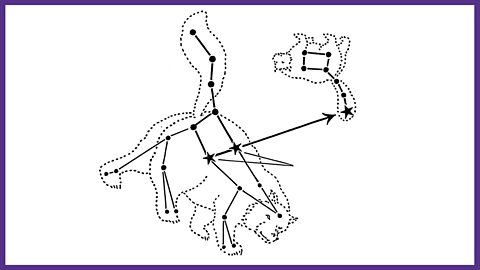
1. Find the Plough.
2. Locate the stars at the edge of the saucepan, called Merak and Dubhe. These are called the тpointer starsт.
3. Follow an invisible line from Merak to Dubhe and from Dubhe continue following this line about five times the distance between the two stars.
4. This star is called Polaris and is also known as the North Star. It lies above the North Pole of the Earth and will show you which way north is. All the other stars in the sky appear to orbit this star. It is also the tip of the tail of Ursa Minor, the star at the end of the handle of this smaller saucepan.
5. Follow the handle around in a slight curve, to find the rest of the stars in the tail/handle. Like the Big Dipper, there are three stars that make up the handle and four that make up the bowl part of the saucepan.
Cygnus - a summer constellation
Cygnus is a constellation that represents a swan. The best viewing conditions are in the summer. Cygnus also lies in front of the band of the Milky Way, which means if you are in a particularly dark sky environment, finding Cygnus will lead you to views of our galaxy!
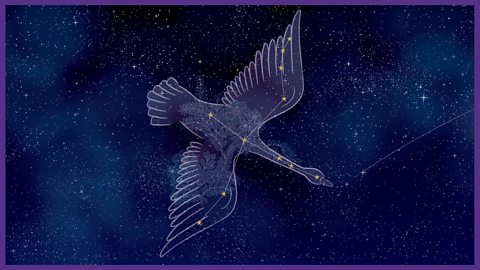
1. The easiest way to find Cygnus is to look for an asterism called the Northern Cross which is a group of stars in a simple cross shape. The other stars in the constellation of Cygnus are extensions of this cross shape.
2. Throughout summer the Northern Cross will rise higher and higher in the south-eastern sky until September when it will be almost directly above an observer in the UK. In late September it will then start moving towards the western horizon.
3. Another way to find Cygnus is to look for an asterism called the Summer Triangle. This is a group of three quite bright stars that are roughly directly above an observer in the UK during summer.
4. The dimmest of these three stars is the star at the end of the tail of Cygnus the swan. From there you should be able to find the Northern Cross at its heart.
Orion - a winter constellation
Orion, one of the most recognisable shapes in our night sky, is a winter constellation in the Northern Hemisphere.

1. Orion can be seen from the UK from September, however only after 02:00. His rising in the sky gets earlier and earlier - by December he is visible after 19:00 and by January he is visible from dusk. Orion starts low in the eastern sky in December, by February it has moved to the south and is still visible in the early evening in the western sky until April.
2. The best way to look for Orion is to find a row of three stars fairly close together. These make up the asterism Orion's Belt.
3. Hanging down below Orionтs Belt is his sword which is a small group of stars, as well as Orionтs Nebula.
4. Orionтs Sword marks about halfway between Orionтs Belt and his knees. His left knee is the brightest star in the constellation called Rigel, and it is a blue supergiant.
5. Follow up from Orionтs knees past his belt to find his shoulders. His shoulder on your left is a red giant star called Betelgeuse. The shoulder on the right is a star called Bellatrix.
6. Halfway between the two shoulders there are a group of stars that make up Orion's head. It is not always possible to make out multiple stars making up the head because they are all quite dim, but usually at least one can be spotted.
7. Following upwards and slightly to the left from Betelgeuse there are three stars that make a тYт shape that makes up his right arm. There are then two stars that are slightly to the right of these stars that make up Orionтs club.
8. Following to the right of Bellatrix you may be able to spot a group of stars in a curved shape that make up Orionтs shield, however this can often be the hardest part of the constellation to spot.

is a science and discovery centre, as well as an educational charity. The Centre has welcomed almost 5 million visitors since opening in 2001, and has a mission to support, educate and inform using the inspiration of space science and exploration. #SpaceForEveryone

More from ТщЖЙдМХФ Bitesize Parents' ToolkitтІ
Parents' Toolkit
Fun activities, real-life stories, wellbeing support and loads of helpful advice - we're here for you and your child.

How to spot the International Space Station
The ISS has been whizzing around Earth for over 20 years - here's how you can spot it.

How to make a moth magnet
Moths are one of the most diverse animals we have in the UK - follow this guide to see them up close!
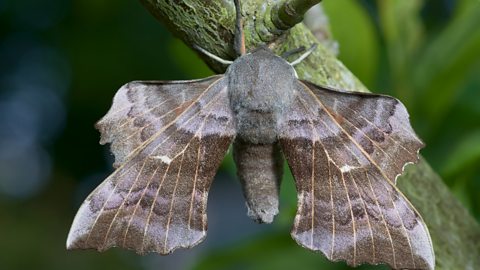
How to spot bats in the UK
Where to find them, how to spot them and some bat facts to wow the kids!
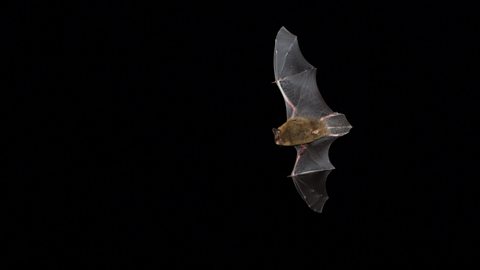
How to catch a meteor shower
You might think spotting a shooting star is pure luck, but there is a way to predict when a meteor shower might hit.
